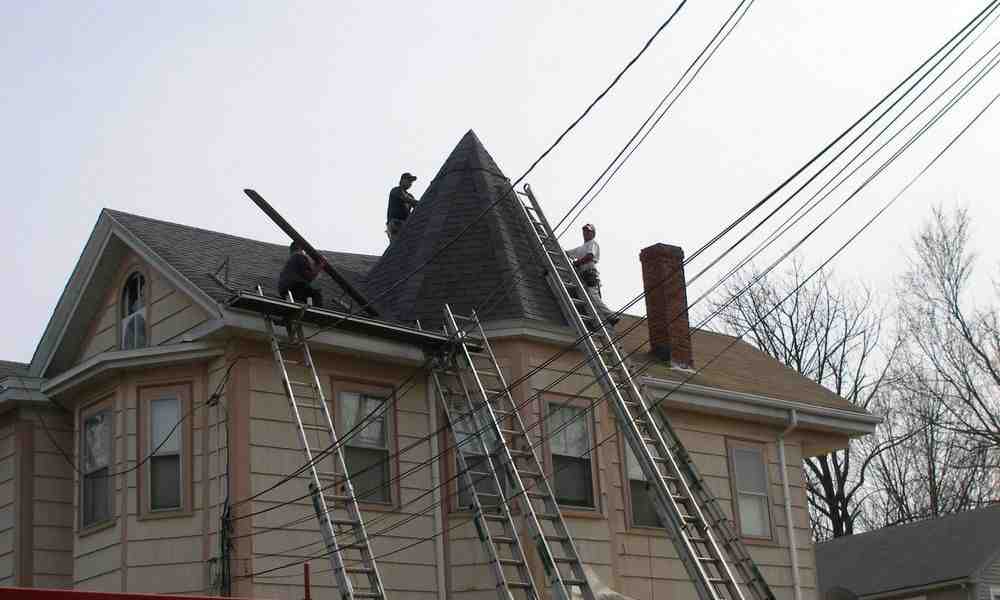Roofing Process Step by Step: Top 10 Essential Tips 2024
Understanding the Roofing Process: Step by Step
When you think about your home’s roof, you probably envision a strong, protective barrier above your head. But do you know what goes into achieving that? The roofing process, step by step, involves a series of precise actions to ensure durability and protection. Here’s a quick look at the roofing process, step by step:
- Obtain the Proper Permits
- Tear Off the Old Roof
- Make Necessary Repairs or Reinforcements
- Lay the Underlayment
- Install the Drip Edge
- Install the Valley Flashing
- Install Starter Shingles
- Nail Down Shingles Row by Row
- Install Step and Dormer Flashing Where Needed
- Add the Vents
- Install the Ridge Cap
- Replace the Gutters
- Final Checks and Clean Up
Each step is crucial for a well-installed roof that can withstand harsh weather and protect your home.
I’m Jack Golini, the owner of Golini Roofing. With over 35 years of experience in the roofing industry, I’ve seen how important it is to follow the roofing process step by step to achieve exceptional results.
Tools and Materials Required
Before you start the roofing process, gather all the necessary tools and materials. This ensures you won’t have to make last-minute runs to the hardware store. Here’s a comprehensive list of what you’ll need:
Tools
- Air Compressor & Air Hose: These power the roofing nailer, making it quicker and easier to nail down shingles.
- Roofing Nailer: This tool is optional but highly recommended for speed and efficiency.
- Circular Saw: Essential for cutting new decking and trimming materials.
- Extension Ladder: Helps you safely access the roof.
- Scaffolding: Provides a stable platform to work from, especially useful for high or steep roofs.
- Roof Safety Harness: Crucial for preventing falls and ensuring your safety while working at heights.
- Caulk Gun: Used for applying sealants around vents, flashing, and other protrusions.
- Chalk Line: Helps in marking straight lines for accurate shingle placement.
- Hook Blades & Utility Knife: Ideal for cutting shingles and other roofing materials.
- Stapler & Staples: Used to secure the underlayment to the roof deck.
- Tin Snips: For cutting metal flashing and drip edges.
- Straightedge: Ensures your cuts and lines are straight.
- Work Gloves: Protect your hands from sharp materials and tools.
Materials
- Asphalt Shingles: The most common roofing material, known for its durability and ease of installation.
- Felt Underlayment: Acts as a protective barrier between the roof deck and shingles, preventing moisture infiltration.
- Self-Adhesive Waterproof Underlayment: Also known as ice barriers, these are crucial in regions with extreme weather.
- Drip Edge: Installed along the edges of the roof to direct water into the gutters and prevent damage to the fascia.
- Roofing Nails: Typically 1-1/4 inches long, these nails are used to secure shingles and underlayment.
- Sealant: Applied around flashing and vents to prevent leaks.
- Step and Dormer Flashing: Used to seal areas where the roof meets walls or dormers.
- Valley Flashing: Installed in roof valleys to direct water off the roof and prevent leaks.
- Vent Flashing: Ensures a watertight seal around roof vents.
- Scaffolding: Provides a stable platform to work from, especially useful for high or steep roofs.
- Work Gloves: Protect your hands from sharp materials and tools.
Having these tools and materials ready will make the roofing process step by step smoother and more efficient.
Next, we’ll dive into the detailed steps of the roofing process, starting with obtaining the proper permits.
Safety Considerations When Roofing
Safety should be your top priority when roofing. Whether you’re a DIY enthusiast or a professional, following these safety guidelines can save lives and prevent injuries.
Helmet and Harness
Wear a Helmet
A helmet can protect you from falling debris, tools, and even falls. It’s a simple way to keep your head safe.
Use a Safety Harness
Always wear a harness, especially when climbing up and down the ladder. Attach it securely to an anchor point on the roof. This can prevent a fall from becoming a disaster.
Tools
Know Your Tools
Roofers use powerful tools like air compressors, nail guns, and circular saws. If you’re not comfortable using any of these, it’s best to get some training first or hire a professional. Mishandling tools can lead to severe injuries.
Weather Conditions
Avoid Bad Weather
Never work on the roof if it’s raining, snowing, or extremely windy. Wet surfaces are slippery, and strong winds can knock you off balance. Always check the weather forecast and choose a clear, calm day for roofing.
Working Alone
Never Work Alone
Always have someone with you. They can hold the ladder, fetch tools, or call for help if needed. Even just having a spotter can make a big difference in safety.
Professional Help
Consider Hiring a Pro
If you’re unsure about any part of the roofing process, it’s wise to hire a professional. They have the experience, tools, and safety training to get the job done right. Falls are the leading cause of injury among roofers, so don’t take unnecessary risks.
Next, we’ll dive into the detailed steps of the roofing process, starting with obtaining the proper permits.
Step-by-Step Roofing Process
Step 1: Obtain the Proper Permits
Before starting any roofing work, obtain the proper permits. Permits are legal requirements in most states to ensure the work meets building codes. Skipping this step can lead to fines and delays. Check with your local building authority for specific requirements.
Step 2: Tear Off the Old Roof
The first physical step is to tear off the old roof. Use a roof shovel or pry bar to remove the old shingles. Start at the top and work your way down. Dispose of the debris properly by renting a dumpster or using a catch-all screen.
Step 3: Make Any Necessary Repairs or Reinforcements
With the old roof removed, inspect the roof deck for damage. Look for water stains, cracks, or any signs of structural issues. Repair any problems to ensure a solid foundation for the new roof.
Step 4: Lay the Underlayment
Next, install the underlayment. This felt paper acts as a protective barrier against water. Nail it down securely, spacing nails about 12 inches apart. This step is crucial for protecting your home from the elements.
Step 5: Install the Drip Edge
Install the drip edge along the edges of the roof. This metal strip helps guide water away from the roof and into the gutters. Position it at a slight angle and make sure the nails are flush to avoid protruding through the shingles.
Step 6: Install Your Valley Flashing
If your roof has valleys, install valley flashing to prevent leaks. Lay it in place and nail it down along the edges. This step ensures these vulnerable areas are watertight.
Step 7: Install Your Starter Shingles
Lay down the starter shingles along the eaves. These help seal gaps between the shingles and the roof edge. Position them so the adhesive strip faces up and secure them with nails.
Step 8: Row by Row, Nail Down Shingles
Now, start laying the shingles. Work from the bottom up, overlapping each row. Nail each shingle in the designated nail zone to ensure they are secure and won’t protrude under the next layer.
Step 9: Install Step and Dormer Flashing Where Needed
For areas where the roof meets a wall, install step flashing. This includes spots around dormers. Step flashing ensures these edges are sealed off from water.
Step 10: Add the Vents
Install any necessary vents for roof ventilation. Place them over pre-cut openings and secure them with nails. Apply sealant around the flashing to prevent leaks.
Step 11: Install Your Ridge Cap
Once the shingles reach the roof’s peak, install the ridge cap. These shingles go in the opposite direction to cover the ridge, ensuring water and ice flow off the roof.
Step 12: Replace Your Gutters
Re-attach or replace the gutters. Clean out any debris and consider installing gutter guards to keep them clear in the future.
Step 13: Final Checks and Clean Up
Perform a final inspection to ensure everything is properly installed and secure. Remove any debris to leave a seamless finish.
Next, we’ll address some frequently asked questions about the roofing process, including what permits are needed and how long the roofing process takes.
Frequently Asked Questions about the Roofing Process
What permits are needed for roofing?
Before starting any roofing project, you need to obtain the proper permits. This is a legal requirement in many areas to ensure that the work meets local building codes. Not having the proper permits can result in fines and even require you to redo the work.
For example, in Massachusetts, a permit is mandatory for any roofing work valued over $2,500. Your roofing contractor should handle the permit process, which involves applying, getting approval, and undergoing inspections.
How long does the roofing process take?
The duration of the roofing process depends on several factors, including the size of your roof and the complexity of the project.
- Average Timeframe: For a home up to 3,000 square feet, the project typically takes about a day.
- Challenges: Special challenges like weather conditions or structural issues can extend this to three to five days.
That professional contractors can complete the job more efficiently than a DIY approach, which can take days or even weeks.
Can I install a new roof over an old one?
While it is technically possible to install a new roof over an old one, it’s generally not recommended. Here are some reasons why:
- Layers: Adding multiple layers can make the roof too heavy, leading to structural issues.
- Installation Issues: Installing over old shingles can hide underlying problems like rot or leaks, which can worsen over time.
- Best Practices: The best practice is to remove the old roof first. This allows for a thorough inspection and ensures that the new roof has a solid foundation.
By following these guidelines, you can ensure a smoother and more effective roofing project.
Conclusion
At Golini Roofing, we understand that the roofing process can seem daunting. Our goal is to make it as smooth and stress-free as possible for you.
Professional Help
Our team of experts is highly trained and experienced in all aspects of roofing. From obtaining the necessary permits to the final inspection, we handle every detail. This ensures that your roof not only looks great but also provides maximum protection for your home.
Quality Assurance
Quality is our top priority. We use only the best materials and follow industry best practices to ensure that your roof stands the test of time. Our rigorous quality checks at every stage of the process guarantee that nothing is overlooked.
Customer Satisfaction
Your satisfaction is important to us. We believe in open communication and keeping you informed at every step. From the initial consultation to the final cleanup, we aim to exceed your expectations. Our commitment to quality and customer service has made us a trusted name in roofing.
By choosing Golini Roofing, you are not just getting a new roof; you are investing in peace of mind. Ready to start your roofing project? Contact us today for a free consultation and see the Golini Roofing difference for yourself.
We hope this guide has given you a clear understanding of the roofing process step by step. Whether you are considering a new roof or need repairs, we are here to help every step of the way.



